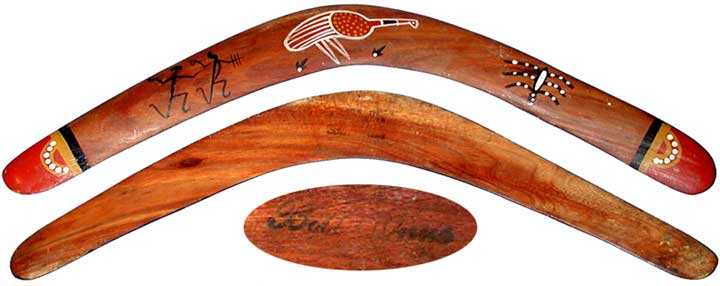Item TB43
This item was sold on 7 August
2006 for $81
Similar artifacts for sale are often found on the Aboriginal
Boomerangs web page.
Historical Pricing information for this item and similar artifacts can be found at: Historical Artifact Prices.
|
Australian Aborigines are well known for making boomerangs. The majority of the Aborigines had the technology to make throwsticks, or non-returning boomerangs. Only a small percentage of the tribal groups knew how to make true returners and most of these came from the eastern coastal regions of Queensland, New South Wales and Victoria. During the past century, the majority of the Aborigines came out of the bush and were somewhat assimilated into the white man's economic system. Many Aborigines began making returning style boomerangs to sell to tourists. The earliest ones were well made out of natural timber and with the grain following the curvature of the boomerang. Today, most hardwood boomerang are cut out of a large board and the grain is usually straight and running parallel to a line spanning the tips of the blades. Boomerangs that are made with the grain following the contour of the blades are much stronger and more valuable. In addition, some boomerangs have good airfoiling. The majority do not. Most "tourist boomerangs" have painted upper surfaces that display Australian animals and decorative lines and/or geometric patterns. Most pre-contact returners have no artwork or the artwork is simple and scratched into the surface. It is easy to tell the tourist boomerang from the valuable ethnographic artifact. However, tourist boomerangs that are made properly with the grain running along the contour and with good airfoiling and artwork do have good collectable value, especially if they are made by a famouns Aboriginal artist like Bill Onus or Joe Timbery. This boomerang is a medium sized returning style boomerang made by one of Australia's most famous Aboriginal boomerang makers. Bill Onus was one of the founders of the Boomerang Association of Australia. He made everything from beautiful natural elbows to longer range models made out of a red fibre material, similar to Paxolin. Bill's workmanship was not nearly as appreciated in the 1960s as it is today, so every Bill Onus boomerang is a good collectable. Bill's handcrafted items and the art painted by his son Lin Onus have appreciated in value a lot of the years. Some of Lin Onus' art has sold in the tens of thousands of dollars in the big auction houses in Australia. This boomerang is a natural elbow. The artwork is very good and typical of the art that Bill painted on most of his boomerangs. The reverse side has the stamped letters " Made in Australia " and his stamped signature. The boomerang was probably capable of a return flight when made. It has a warp made for right handed thrower tuning and warpage that gives negative dihedral to the dingle that is associated with the wood loosing moisture over the years. This one was probably made in the 1950s. There is no noticeable damage anywhere, except for the slight warpage on the dingle arm. This one would display nicely on the wall. Length = 47 cm. Weight = 108 gm. |

Back to: Collectable Artifacts | Aboriginal Boomerangs | Historical Artifact Prices | Primitive Technology | contact: Ted Bailey